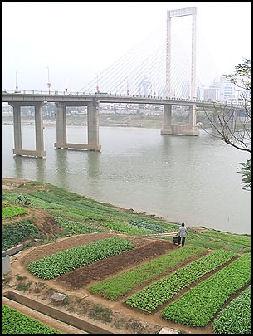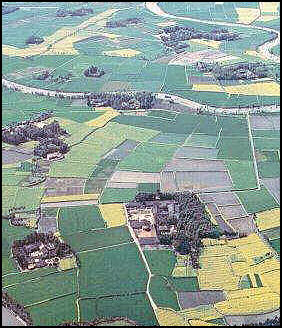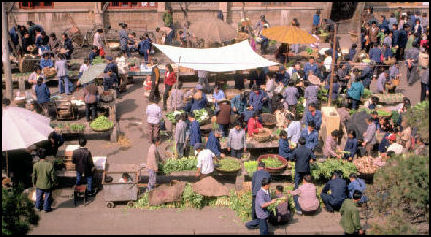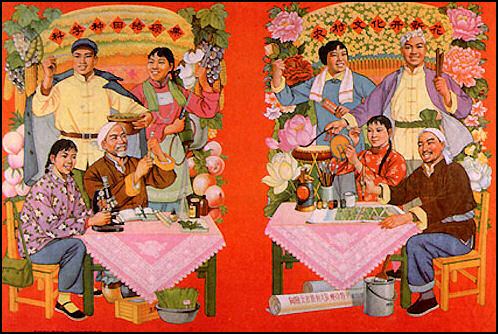DENG-ERA AGRICULTURE IN CHINA

Using all available land in Nanjing
In 1979, three years after Mao's death, Deng Xiaoping began dismantling the "rigidly" controlled agriculture collectives and encouraging farmers to raise crops in individual plots. According to rules that varied from province to province, farmers were allowed to hire a certain numbers of laborers, and sell their surplus. Peasants were not allowed to own land but they were given long term leases and rights to renew the leases so their was an incentive for them to take care of the land. Land rights — except in terms of buying, selling and titled ownership — was given to agriculture labor organization to individual families. In effect the pre-revolutionary system was restored with state holding claim to part of the crop instead of the landlord.
In the 1980s, families in areas affected by the reforms were given a little over half an acre to tend. Those that possessed good fertile land were able to make a healthy profits growing rice, vegetables, sugar and other products. Those that wanted more joined together with other farmers and improved irrigation and roads and became more productive an made even more money. Deng also introduced incentive price bonuses for above-quota grain production and launched a "responsibility system" which allowed farmers to sell surplus crops on the open market after the met their government quotas. In 1984, in an effort to increase production, the quota was dropped completely in 1984 for all crops expect cotton and grain.
Even though many farmers used hoes instead of tractors, crop yields jumped dramatically. Wheat production doubled between 1978 and 1985 from 41 million to 87 million tons. By 1987 the output of grains and tubers was three times that of India and almost equal to that of the U.S. and Soviet Union. Agriculture has been neglected in the later stages of the economic reforms. By the 1990s the benefits received by farmers began to level off and the real farm incomes decreased as the costs of fertilizer, hybrid seeds and other necessities rose faster than crop prices.
Good Websites and Sources on Deng Xiaoping: Wikipedia article Wikipedia ; CNN Profile cnn.com ; New York Times Obituary; China Daily Profile chinadaily.com. ; Wikipedia article on Economic Reforms in China Wikipedia ; Wikipedia article on Special Economic Zones Wikipedia ;
RELATED ARTICLES IN THIS WEBSITE: AFTER MAO factsanddetails.com; POLITICAL REFORM AND SOCIALIST DEMOCRACY UNDER DENG XIAOPING factsanddetails.com; DENG XIAOPING'S EARLY ECONOMIC REFORMS factsanddetails.com; DENG XIAOPING STEPS UP HIS ECONOMIC REFORMS: SEZS AND HIS SOUTHERN TOUR factsanddetails.com; ECONOMIC HISTORY AFTER DENG XIAOPING Factsanddetails.com/China
RECOMMENDED BOOKS: Deng Xiaoping “Deng Xiaoping and China's Economic Miracle” by Rene Schreiber Amazon.com; “China Under Deng Xiaoping: Political and Economic Reform” by John; David Watkin & G.Tilman Mellinghoff Summerson, illustrated Amazon.com; “Idealogy and Economic Reform Under Deng Xiaoping 1978-1993" by Wei-Wei Zhang Amazon.com; "Deng Xiaoping and the Transformation of China" by Ezra F. Vogel (Belknap/Harvard University, 2011) Amazon.com; “Deng Xiaoping: A Revolutionary Life” by Alexander V. Pantsov and Steven I. Levine Amazon.com; "Deng Xiaoping: My Father" by Deng Maomao (1995, Basic Books) Amazon.com; “Deng Xiaoping's Long War: The Military Conflict between China and Vietnam, 1979-1991" by Xiaoming Zhang Amazon.com; “The Deng Xiaoping Era: An Inquiry into the Fate of Chinese Socialism, 1978-1994" by Maurice Meisner Amazon.com; "Burying Mao: Chinese Politics in the Age of Deng Xiaoping" by Richard Baum (1996, Princeton University Press) Amazon.com; "Deng Xiaoping and the Chinese Revolution: A Political Biography" by David S.G. Goodman (1994, Routledge) Amazon.com; "Deng Xiaoping: Chronicle of an Empire" by Ruan Ming (1994, Westview Press) Amazon.com; "Deng Xiaoping and the Making of Modern China" by Richard Evans 1993 Amazon.com; "Deng Xiaoping: Portrait of a Chinese Statesman" edited by David Shambaugh (1995, Clarendon Paperbacks) Amazon.com; "The New Emperors: Mao and Deng — a Dual Biography" by Harrison E. Salisbury (1992, HarperCollins) Amazon.com After Mao “China After Mao: The Rise of a Superpower” by Frank Dikötter, Daniel York Loh, et al. Amazon.com; “Mao's China and After: A History of the People's Republic” by Maurice Meisner Amazon.com; “The Souls of China: The Return of Religion After Mao” by Ian Johnson Amazon.com; The Cambridge History of China, Vol. 15: The People's Republic, Part 2: Revolutions within the Chinese Revolution, 1966-1982" by Roderick MacFarquhar, John K. Fairbank Amazon.com; "The Penguin History of Modern China" by Jonathan Fenby Amazon.com; “The Search for Modern China” by Jonathan D. Spence Amazon.com
Deng's Economic Reforms in the Countryside
The post-Mao Communist Party government under Deng Xiaoping began its program of economic reform in the countryside, where peasants were encouraged to participate in the market economy. Communes and collectives were dismantled and were divided up into plots of land that was leased back to peasants who were encouraged to raise crops to sell in private markets.

Farmland in Sichuan
The reforms began with the "household contract" and "responsibility system," developed and launched quietly in 1978 by an 18-year-old villager, Yan Hongchang, who started a production group with the leaders of 20 villages. In the little-known village of Xiaogang in east Anhui Province 18 farmers signed a secret agreement to divide communally owned farmland into individual sections called “household contracts”. At the time, this should have been regarded as a hefty “counter-revolutionary crime”. But the experiment won the support of Deng and was quickly implemented across the nation, becoming the first major breakthrough in economic reform and opening up. In the late 1970s, Chinese farmers and rural cadres were frustrated with the commune system, seeing it as an obstacle to improving agricultural production and their lives. Thus, Xiaogang village's privatization experiment quickly won popular support and was opposed only by a few diehard Maoist ideologues and conservatives.
Later the "responsibility system" became common place all over China and incentive price bonuses for above-quota grain production were introduced. Many have said that Deng set up a system that allowed the Chinese do what they do best — make money. The system relied on Township and Village enterprises (TVEs), which produced a class of wealthy and corrupt autocrats.
The early economic reforms meant that people could make money selling produce at local markets and doing work at home, such as mending clothes, repairing pots, or giving piano lessons, and opening up small businesses. One official told Theroux in 1988, "China is the first stage of socialism — we are just beginning to develop. In some ways, we are underdeveloped and we are proceeding slowly and carefully. In the countryside the reforms have gone smoothly. But in the cities much remains to be done."
Deng Xiaoping’s Agricultural Reforms (1980)
According to Columbia University’s Asia for Educators: “ Under Mao Zedong (1893-1976), family farming had been eliminated as farmers, their land, animals, and equipment were first organized into agricultural cooperatives and then into vast people’s communes in which agricultural work was completely collectivized. Deng’s policy was to allow the communes to assign land to individual farming families on a contract basis. The family, now the basic unit of production, was under contract to sell the state a certain amount of grain at a fixed price. They could sell the surplus on the market at market prices. These reforms, combined with good weather, resulted in sharp increases in production and significant increases in average family income and standards of living in the early to mid-1980s. [Source: Asia for Educators, Columbia University, Primary Sources with DBQs, afe.easia.columbia.edu ]
By the end of 1984, approximately 98 percent of the old production teams had adopted the contract responsibility system, and all but 249 communes had been dissolved, their governmental functions passed on to 91,000 township and town governments. Production team organizations were replaced by 940,000 village committees. Under the responsibility system, farm families no longer devoted most of their efforts to collective production but instead generally signed contracts with the village or town to cultivate a given crop on a particular piece of land. After harvest a certain amount of the crop had to be sold to the unit at a predetermined price, and any output beyond that amount was the property of the family, either to be sold in the market or to be consumed. Beyond the amount contracted for delivery to the collective, farmers were allowed to determine for themselves what and how to produce. [Source: Library of Congress *]

Daily life in much of China
Market activity played a central role in the rural economy of the 1980s. Farmers sold a growing share of their produce in rural or urban free markets and purchased many of the inputs that had formerly been supplied by the team or brigade. A prominent new institution that thrived in the market environment was the "specialized household." Specialized households operated in the classic pattern of the entrepreneur, buying or renting equipment to produce a good or service that was in short supply locally. Some of the most common specialties were trucking, chicken raising, pig raising, and technical agricultural services, such as irrigation and pest control. Many of the specialized households became quite wealthy relative to the average farmer. *
The new economic climate and the relaxation of restrictions on the movements of rural residents gave rise to numerous opportunities for profit-making ventures in the countryside. Towns, villages, and groups of households referred to as "rural economic unions" established small factories, processing operations, construction teams, catering services, and other kinds of nonagricultural concerns. Many of these organizations had links with urban enterprises that found the services of these rural units to be less expensive and more efficient than those of their formal urban counterparts. *
The growth of these nonagricultural enterprises in the countryside created a large number of new jobs, making it possible for many workers who were no longer needed in agriculture to "leave the land but stay in the country," significantly changing the structure of the rural economy and increasing rural incomes. In 1986 nonagricultural enterprises in the countryside employed 21 percent of the rural labor force and for the first time produced over half the value of rural output. *
See From the Office of the CCP Dehong Dai Nationality and Qingbo Autonomous Zhou Committee: “Several Questions in Strengthening and Perfecting the Job Responsibility Systems of Agricultural Production” (1980) [PDF] afe.easia.columbia.edu
See How Should the Criteria for Admission to the Communist Youth League Be Administered After Installation of the Production Responsibility System? (1981) [PDF] afe.easia.columbia.edu
Decollectivization in China

Shop in Shanghai in 1980
Under the collectivized system, grain production kept up with population growth (China's population nearly doubled from 1950 to 1980), and the rural population was guaranteed a secure but low level of subsistence. But the collectivized system seemed to offer few possibilities for rapid economic growth. There was some discontent with a system that relied so heavily on orders from above and made so little allowance for local conditions or local initiative. In the late 1970s, administrators in provincial-level units with extensive regions of low yields and consequent low standards of living began experimenting with new forms of tenure and production. In most cases, these took the form of breaking up the collective production team, contracting with individual households to work assigned portions of collective land, and expanding the variety of crops or livestock that could be produced. The experiments were deemed successful and popular, and they soon spread to all districts. By the winter of 1982-83, the people's communes were abolished; they were replaced by administrative townships and a number of specialized teams or businesses that often leased such collective assets as tractors and provided services for money. [Source: Library of Congress *]
“The agricultural reforms of the early 1980s led to a confusingly large number of new production arrangements and contracts. Underlying the variability of administrative and contractual forms were several basic principles and trends. In the first place, land, the fundamental means of production, remained collective property. It was leased, allocated, or contracted to individual households, but the households did not own the land and could not transfer it to other households. The household became, in most cases, the basic economic unit and was responsible for its own production and losses. Most economic activity was arranged through contracts, which typically secured promises to provide a certain amount of a commodity or sum of money to the township government in return for the use of land, or workshops, or tractors. *
“The goal of the contracting system was to increase efficiency in the use of resources and to tap peasant initiative. The rigid requirement that all villages produce grain was replaced by recognition of the advantages of specialization and exchange, as well as a much greater role for markets. Some "specialized households" devoted themselves entirely to production of cash crops or provision of services and reaped large rewards. The overall picture was one of increasing specialization, differentiation, and exchange in the rural economy and in society in general. Rural incomes increased rapidly, in part because the state substantially increased the prices it paid for staple crops and in part because of economic growth stimulated by the expansion of markets and the rediscovery of comparative advantage. *
Chinese Communes After Deng Reforms

farmer in 1991
Under Deng, some communes were kept going. Members of the most productive collective in China, the Western Pass Commune near Shandong, saw their earnings per person jump from about 100 yuan in 1971 to 9,000 yuan in 1986. In 1971, the commune had one function: raising wheat. Beginning in 1979, each person was given about a 1,000 yuan a year and the rest of the money earned by the commune was reinvested into the commune. After 1979 the commune began raising many kinds of crops and later it opened a hotel, set up transportation services and established different kinds of industries. The commune even had a hospital with modern equipment. Other communes didn’t do so well. Some commune workers go months without getting paid.
Most communes and collectives were broken up or abandoned and their land was divided up among private landowners. In most cases the commune land was divided equally among families that lived on the commune, leaving some places dotted with farms that were only a fifth of an acre in size.
Farming households typically received about a half acre per person to cultivate themselves. They had to pay for seeds and fertilizer themselves and fulfil production quotas but otherwise they were free to grow what the wanted. Many grew lucrative crops they could sell for profit such as melons. In many cases productivity increased and harvests were much bigger.
China's 700 million farmers are largely considered independent. Still they raise crops on government land and many sell them to state-owned grain companies. Some collective farms were purchased entrepreneurs and turned into large farms that grow cash crops.
Improved Crop Yields After Deng Reforms
In 1949 China could only support about seven of its citizens on a hectare of land now it can support about 12 people on that amount of land. With tractors, fertilizers and improved seeds in some cases 60 farmers can raises as much food as 1,200 people 20 years ago.
Crops yields have been improved through intercropping, interplanting, winter farming, improved technology and using plastic greenhouses to raise vegetables out of season. Mainly with the help of irrigation and flood control schemes, food production in China doubled between 1952 and 1992. The use of chemical fertilizer increased four times from 1978 to 1993 but the grain output was only 50 percent higher. These improvements have been cancelled out as the amount of arable land has shrunk and the population increases.
Consequences of Rural Reform in China
Decollectivization increased the options available to individual households and made household heads increasingly responsible for the economic success of their households. In 1987, for example, it was legally possible to leave the village and move into a nearby town to work in a small factory, open a noodle stand, or set up a machine repair business. Farmers, however, still could not legally move into medium-sized or large cities. The Chinese press reported an increased appreciation in the countryside for education and an increased desire for agriculturally oriented newspapers and journals, as well as clearly written manuals on such profitable trades as rabbit-raising and beekeeping. As specialization and division of labor increased, along with increasingly visible differences in income and living standards, it became more difficult to encompass most of the rural population in a few large categories. During the early 1980s, the pace of economic and social change in rural China was rapid, and the people caught up in the change had difficulty making sense of the process. [Source: Library of Congress *]

Deng-era farmer's market
The state retained both its powers and its role in the rural economy in the 1980s. Decollectivization, like the collectivization of the 1950s, was directed from the top down. Sometimes, apparently, it was imposed on communities that had been content with their collective methods. But in permitting households and communities greater leeway to decide what to produce and in allowing the growth of rural markets and small-scale industries, the state stepped back from the close supervision and mandatory quotas of the 1960s and 1970s. *
Decollectivization obviated the supervisory functions of lowlevel cadres, who no longer needed to oversee work on the collective fields. Some cadres became full-time administrators in township offices, and others took advantage of the reforms by establishing specialized production households or by leasing collective property at favorable rates. Former cadres, with their networks of connections and familiarity with administrative procedures, were in a better position than ordinary farmers to take advantage of the opportunities offered by the growth of markets and commercial activity. Even those cadres not wholly devoted to increasing their own families' income found that to serve their fellow villagers as expected it was necessary to act as entrepreneurs. Village-level cadres in the mid-1980s were functioning less as overseers and more as extension agents and marketing consultants. *
By 1987 rural society was more open and diverse than in the 1960s and 1970s, and the rigid collective units of that period, which had reflected the state's overwhelming concern for security, had been replaced by networks and clusters of smaller units. The new, looser structure demonstrated the priority placed on efficiency and economic growth. Basic security, in the sense of an adequate supply of food and guarantees of support for the disabled, orphaned, or aged, was taken for granted. Less than half of China's population remembered the insecurity and risks of pre-1950 society, but the costs and inefficiencies of the collective system were fresh in their minds. Increased specialization and division of labor were trends not likely to be reversed. In the rural areas the significance of the work unit appeared to have diminished, although people still lived in villages, and the actions of low-level administrative cadres still affected ordinary farmers or petty traders in immediate ways.*
The state and its officials still dominated the economy, controlled supplies of essential goods, taxed and regulated businesses and markets, and awarded contracts. The stratification system of the Maoist period had been based on a hierarchy of functionally unspecialized cadres directing the labors of a fairly uniform mass of peasants. It was replaced in the 1980s by a new elite of economically specialized households and entrepreneurs who had managed to come to terms with the administrative cadres who controlled access to many of the resources necessary for economic success. Local cadres still had the power to impose fees, taxes, and all manner of exactions. The norms of the new system were not clear, and the economic and social system continued to change in response to the rapid growth of rural commerce and industry and to national economic policies and reforms. *

Scientific farming poster
Increased commercial activity produced a high degree of normative ambiguity, especially in areas like central Guangdong and Jiangsu provinces, where rural economic growth was fastest. Neither the proper role of local officials nor the rights and obligations of new entrepreneurs or traders were clear. The line between the normal use of personal contacts and hospitality and extraordinary and criminal favoritism and corruption was ambiguous. There were hints of the development of a system of patron-client ties, in which administrative cadres granted favors to ordinary farmers in return for support, esteem, and an occasional gift. The increased number of corruption cases reported in the Chinese press and the widespread assumption that the decollectivization and rural economic reforms had led to growing corruption probably reflected both the increased opportunities for deals and favors of all sorts and the ambiguous nature of many of the transactions and relationships. The party's repeated calls for improved "socialist spiritual civilization" and the attempts of the central authorities both to create a system of civil law and to foster respect for it can be interpreted as responses to the problem. On the local level, where cadres and entrepreneurs were engaged in constant negotiation on the rules of their game, the problem was presumably being addressed in a more straightforward fashion. *
Image Sources: Landsberger Posters http://www.iisg.nl/~landsberger/; Commune in the 11950s, Ohio State University; Deng-era market, Nolls China website http://www.paulnoll.com/China/index.html, Wiki Commons; Asia Obscura
Text Sources: New York Times, Washington Post, Los Angeles Times, Times of London, National Geographic, The New Yorker, Time, Newsweek, Reuters, AP, Lonely Planet Guides, Compton’s Encyclopedia and various books and other publications.
Last updated August 2012
